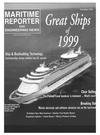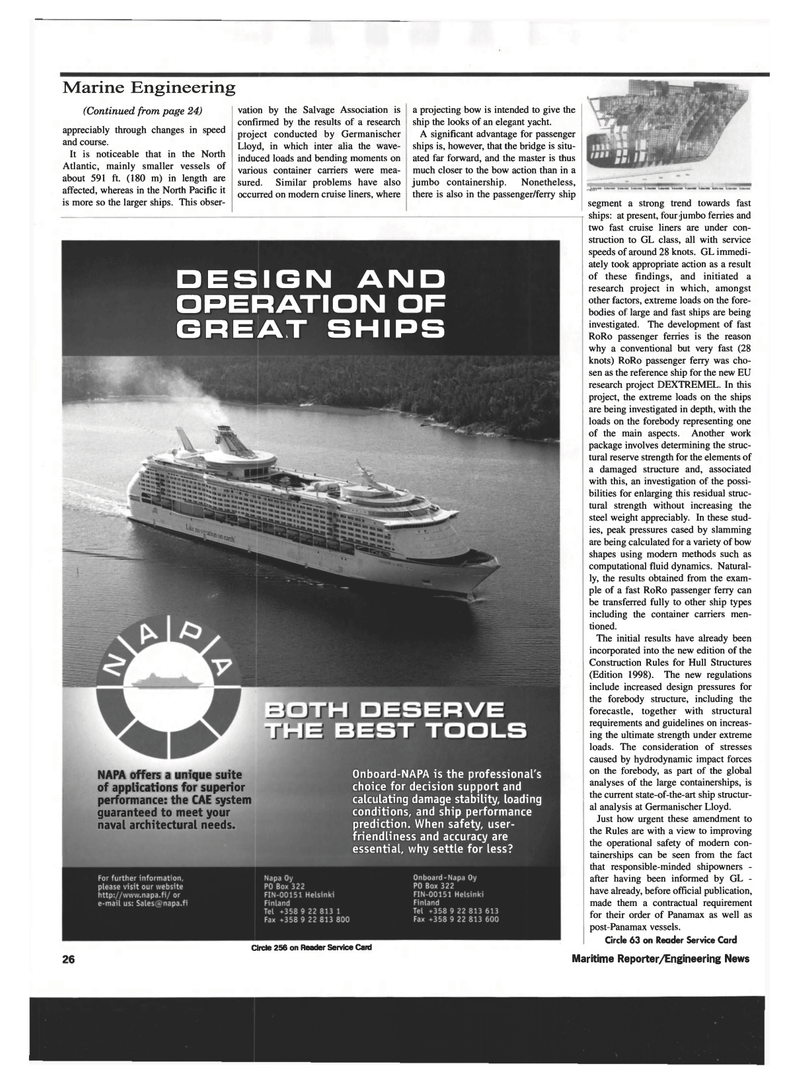
Page 26: of Maritime Reporter Magazine (December 1999)
Read this page in Pdf, Flash or Html5 edition of December 1999 Maritime Reporter Magazine
Marine Engineering (Continued from page 24) appreciably through changes in speed and course.
It is noticeable that in the North
Atlantic, mainly smaller vessels of about 591 ft. (180 m) in length are affected, whereas in the North Pacific it is more so the larger ships. This obser- vation by the Salvage Association is confirmed by the results of a research project conducted by Germanischer
Lloyd, in which inter alia the wave- induced loads and bending moments on various container carriers were mea- sured. Similar problems have also occurred on modern cruise liners, where a projecting bow is intended to give the ship the looks of an elegant yacht.
A significant advantage for passenger ships is, however, that the bridge is situ- ated far forward, and the master is thus much closer to the bow action than in a jumbo containership. Nonetheless, there is also in the passenger/ferry ship
DESIGN AND
OPERATION OF
GREAT SHIPS
Circle 256 on Reader Service Card 26 segment a strong trend towards fast ships: at present, four jumbo ferries and two fast cruise liners are under con- struction to GL class, all with service speeds of around 28 knots. GL immedi- ately took appropriate action as a result of these findings, and initiated a research project in which, amongst other factors, extreme loads on the fore- bodies of large and fast ships are being investigated. The development of fast
RoRo passenger ferries is the reason why a conventional but very fast (28 knots) RoRo passenger ferry was cho- sen as the reference ship for the new EU research project DEXTREMEL. In this project, the extreme loads on the ships are being investigated in depth, with the loads on the forebody representing one of the main aspects. Another work package involves determining the struc- tural reserve strength for the elements of a damaged structure and, associated with this, an investigation of the possi- bilities for enlarging this residual struc- tural strength without increasing the steel weight appreciably. In these stud- ies, peak pressures cased by slamming are being calculated for a variety of bow shapes using modern methods such as computational fluid dynamics. Natural- ly, the results obtained from the exam- ple of a fast RoRo passenger ferry can be transferred fully to other ship types including the container carriers men- tioned.
The initial results have already been incorporated into the new edition of the
Construction Rules for Hull Structures (Edition 1998). The new regulations include increased design pressures for the forebody structure, including the forecastle, together with structural requirements and guidelines on increas- ing the ultimate strength under extreme loads. The consideration of stresses caused by hydrodynamic impact forces on the forebody, as part of the global analyses of the large containerships, is the current state-of-the-art ship structur- al analysis at Germanischer Lloyd.
Just how urgent these amendment to the Rules are with a view to improving the operational safety of modern con- tainerships can be seen from the fact that responsible-minded shipowners - after having been informed by GL - have already, before official publication, made them a contractual requirement for their order of Panamax as well as post-Panamax vessels.
Circle 63 on Reader Service Card
Maritime Reporter/Engineering News
Onboard-NAPA is the professional's choice for decision support and calculating damage stability, loading conditions, and ship performance prediction. When safety, user- friendliness and accuracy are essential, why settle for less?
NAPA offers a unique suite of applications for superior performance: the CAE system guaranteed to meet your naval architectural needs.

 25
25

 27
27
